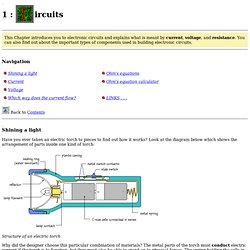

Series and Parallel Connections. Conductors and Insulators. After reading this section you will be able to do the following: Contrast the characteristics of conductors and insulators.

List examples of common conductors and insulators. Explain how insulators provide protection from electricity. In the previous pages, we have talked a bit about “conductors” and “insulators”. We will discuss these two subjects a little more before moving on to discuss circuits. Conductors. Circuits & Conductors - Fun Electricity Science Games & Activities for Kids. The Parallel Circuit. After reading this section you will be able to do the following: Define a parallel circuit and explain how it compares to a series circuit.

Construct a parallel circuit. Explain what a voltmeter does and how it is different from an ammeter. Like the series circuit, parallel circuits also contain a voltage (current) source as well as wires and other components. The main difference between a series circuit and a parallel circuit is in the way the components are connected. Try building this simple parallel circuit Congratulations! A parallel circuit exists whenever two or more components are connected between the same two points. Each parallel path is called a branch of the parallel circuit. Try building this parallel circuit, now including a voltmeter This parallel circuit contains 3 branches (two resistors and a voltmeter), which means the electron current goes through all three branches at the same time. Review. LTSchpt11. Readings - Electricity. Electric charges On a dry day in summer, people who have been jumping on a trampoline sometimes get a small electric chock as they get off.

On a stormy night there may be lightning flashes in the sky followed by the loud claps of thunder. If you place your hand near a television screen, you may feel the hairs on the back of your hand being attracted towards the screen. These are just a few examples of electric charges. If an electric charge passes through your body, you may feel an electric shock. Making electric charges You can make electric charges with the right materials and when the environment is relatively dry. If you rub a plastic ruler (or any other plastic object) on a piece of woollen jumper, you will find that the plastic ruler will attract the hairs on the back of your hand. Atoms and charges All things, even the plastic ruler and the woollen cloth, are composed of very, very small particles called atoms. An atom has a spherical shape like a ball.
Shifting electric charges Current. How to Build a Circuit With a Battery. 9781420229752. Circuits. .

Navigation Back to Contents .Shining a light Have you ever taken an electric torch to pieces to find out how it works? Look at the diagram below which shows the arrangement of parts inside one kind of torch: Structure of an electric torch Why did the designer choose this particular combination of materials? The lamp and reflector make up an optical system, often intended to focus the light into a narrow beam.
A torch is a simple product, but a lot of thought is needed to make sure that it will work well. A different way of describing the torch is by using a circuit diagram in which the parts of the torch are represented by symbols: Circuit diagram of an electric torch There are two electric cells ('batteries'), a switch and a lamp (the torch bulb). A circuit is a closed conducting path. Up .Current An electric current is a flow of charged particles. Current is represented by the symbol I, and is measured in amperes, or 'amps', A. .Voltage In the torch circuit, what causes the current to flow?
Engineering Interact - Interactive science & engineering for 9-11 year olds. Absorb Electronics.